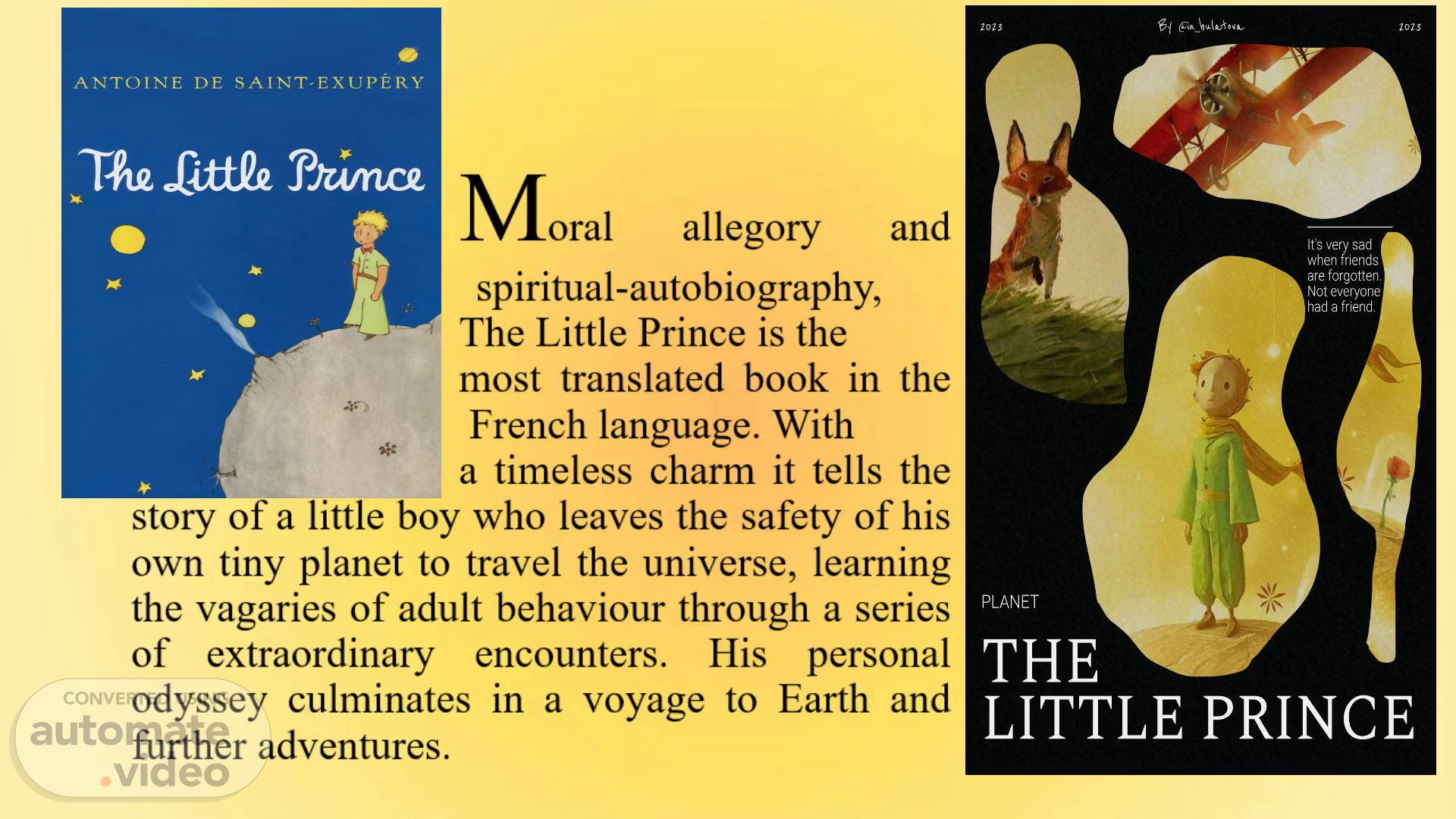
Moral allegory and spiritual-autobiography, The Little Prince is the most translated book in the French language. With a timeless charm it tells the story
Scene 1 (0s)
Moral allegory and spiritual-autobiography, The Little Prince is the most translated book in the French language. With a timeless charm it tells the story of a little boy who leaves the safety of his own tiny planet to travel the universe, learning the vagaries of adult behaviour through a series of extraordinary encounters. His personal odyssey culminates in a voyage to Earth and further adventures..
Scene 2 (23s)
Antione De Saint-Exupe. A pointer of aviation and a well-known French writer. He was born in Lyon, France, in 1900. At an early age, he dreamed of a life of adventure and wanted to become a naval officer..
Scene 3 (37s)
SUMMARY / SYNOPSIS OF THE STORY.
Scene 4 (44s)
An aircraft pilot crashes his plane in Sahara Desert, far from civilzation. There, he is unexpectedly greeted by a young boy nicknamed “ the little prince”. The prince has golden hair, a loveable laugh, and will repeat questions until they are answered. While the narrotor/avaitor attempts to repair his, the prince recounts his life story. He begins describing his tiny home planet- a house-sized asteroid known as “B-612” on Earth. The prince shares that his planet has a rose and tree volcanoes. Then prince then shares that he has traveled from planet to planet, meeting different and unique individuals. Since the price visited six other planets, each of which was inhabited by single, irrational, narrow-minded adults, each meant to critique an element of society. The story of The Little Prince shows that people do find the truth by seeking it with their hearts and minds, rather than just paying attention to what they can see on the surface. The little prince is full of sad things and about innocence. Sure, there is joy, friendship, love, and understanding but all that is touched by sadness, especially once we get to the end of the book..
Scene 5 (1m 33s)
Every time the characters come closer to understanding, they come closer to loss. Usually, it is not until the characters say goodbye or part, that they realize their love for one another. The rose didn’t tell the prince she loves him until they say goodbye. Similarly, even though the fox wanted to be tamed, he didn’t know the full pleasure or pain of it untl the prince left him. And the narrator is no exception. By the time the narrator writes down his story, it is been six years since the prince left him behind. Although he can hear his friend’s laughter in the stars, that’s not the same as hearing it in person. It is about the paradoxes of adulthood and the loneliness of growing up. It’s a story about the naivety and pureness of youth teaching an adulth to find joy in simple things. It explores love, friendship, and loss. The little prince makes observations about life, adults and human nature..
Scene 6 (2m 16s)
The Elements of the Story.
Scene 7 (2m 22s)
Characters. The Aviator: The narrator of the novel, is an aviator by a professional who has crash-landed in some part of the Sahara desert where he meets the Little Prince. The Little Prince: The Little Prince is protagonist and the central character around whom the entire story revolves. The child-like character is very simple, easy-to-deal, and naive person. The fox: The fox is important as the fox makes the prince realizes that the worth-loving things are invisible. The roses: The rose also becomes a character when it comes into contact with the Little Prince. The Little Prince has personified the rose as a female. Having fickleness with temporary beauty and flirtatious nature..
Scene 8 (2m 53s)
The King: A king with no subjects, who only issues orders that can be followed, such as commanding the sun to set at sunset. The Vain Man:A man who only wants the praise which comes from admiration and being the most-admirable person on his otherwise uninhabited planet. The Drunk Man: A drunkard who drinks to forget the shame of drinking. The Entrepreneur: A businessman who blinded by the beauty of the stars and instead, endlessly counts and catalogs them in order to “own” them all. The Lamplighter: A lamplighter on planet so small, a full day last a minute. He wastes his life blindly following orders to extinguish and relight the lamp-post every 30 seconds to correspond with his planet’s day and night. The Geographer: An elderly geographer who has never been anywhere, or seen any of the things he records, providing a caricature of specialization in the contemporary world. The Snake: The snake makes him realize that he can send the Little Prince back home through his poison..
Scene 9 (3m 36s)
Tone and Mood Tone: solemn, sad, thoughtful Mood: melancholy, contemplative, beautiful Theme Love, friendship, englightenment through exploration, appreciation of the little things, and loss..
Scene 10 (3m 49s)
Point of view At the beginning and the end part of the story, the aviator/narrator is using the first person point of view in telling the story. When the little prince embarked on his adventures on different planets, the narrator narrated it in the third person-omniscient point of view. The Use of Figures of Speech Imagery imagery is used to make readers perceive things involving their five senses..
Scene 11 (4m 10s)
Hyperbole it is an extreme exaggeration ( not to be taken literally) to make a point or show emphasis. Smile When two dissimilar objects or concepts are compared with one another through the use of “like” or “as”..
Scene 12 (4m 29s)
"And nozv here is my secret, a very simple secret: It is only with the heart that one can see rightly; what is essential is invisible to the eye." -The Fox (The Little Prince, 1943).